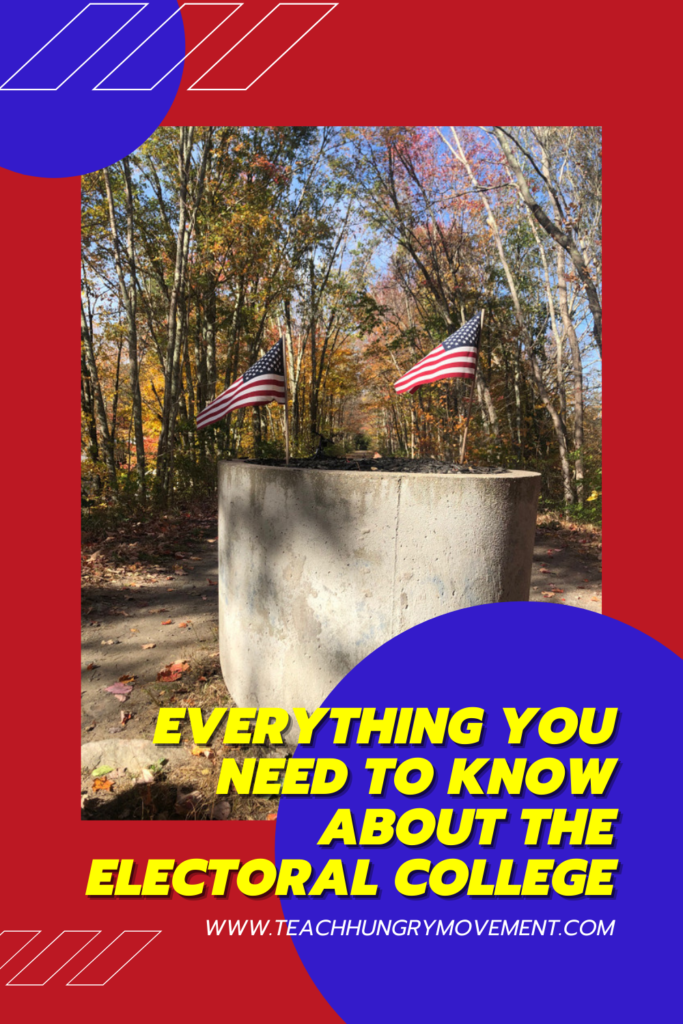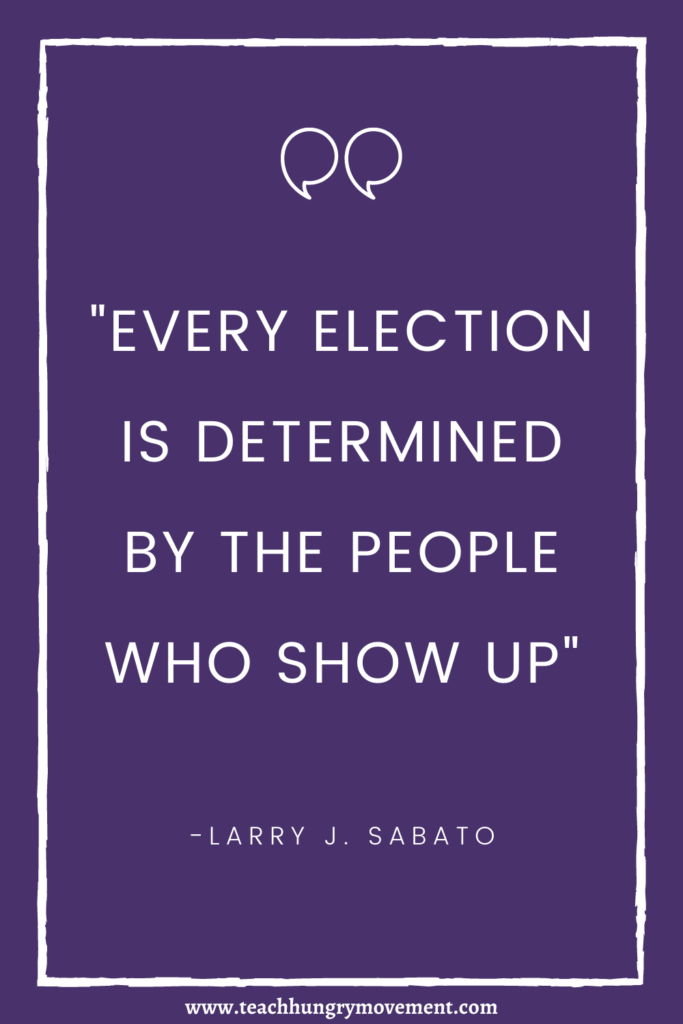Do you believe in magic? Well, the Electoral College sure does. It’s a magic number, and it’s 270. That’s the number you’ll see sprawled across the top of all the news channels on election day. It’s the number of electoral votes a candidate needs to win the presidential election. So I figured I’ll explain the Electoral College

You’re probably thinking, “my vote doesn’t count, so why should I vote?” Fair. But, if you live in a swing state, you vote counts. BIG TIME. The national Presidential Election is the only election where your “vote doesn’t count.” But it does, so vote. (If you stay home, you can swing the Electoral College vote. Really).
People have straight up asked me. “What’s the Electoral College? I don’t get how it works.”
The Electoral College is pretty simple.
It’s important to remember that the Electoral College is only for PRESIDENTIAL elections. ALL other elections are decided by popular vote.
Here are some questions people ask me most often.
1. What is the Electoral College?
- It’s a group of people (electors) selected by each state to choose the president and vice president.
- The magic number of electoral votes is 270 out of the available 538 electoral votes.
2. Why do we have an Electoral College
- The Founding Fathers thought average Americans were too stupid to choose the president. And they probably were. We are much more educated and connected today. (Remember, it was 1789, so we mean white, male, property owners. They were the only people who could vote at the time).
- Southern states wanted their enslaved black people to count for representation in Congress. (Even though they weren’t considered people and had zero rights. But hey, power corrupts, right?) The Northern states obviously didn’t want that to happen. It wasn’t out of the kindness of their hearts. They didn’t want to be steamrolled by the Southern states.
- The remedy? One of the most despicable rulings in U.S. History: The Three-Fifths Compromise. This law counted each enslaved black person as three-fifths of a person. What the actual f. But, if you know anything about U.S. History, you’re likely not surprised.
- The Three-Fifths compromise gave Southern states more representation than many Northern states. It also gave them more representation in the Electoral College. So yes, there is racism oozing from the establishment of the Electoral College. And there are still ways that the Electoral College disadvantages people of color. (Check out the video from Vox that I linked below. It does a great job of explaining the electoral college and how it negatively impacts people of color).
3. How does it work?
- Each state gets two senators. The population of your state determines the number of U.S. Representatives you get. There’s a total of 435 representatives in the House). To get the number of electoral votes your state gets, add those numbers together. I live in Tennessee. We have two U.S. Senators and nine U.S. Representatives, so TN has 11 electoral votes.
- In most states, once the popular vote is tallied, ALL the electoral votes go to the person who won the popular vote. This is called the winner-take-all system.
- Only two states, Maine and Nebraska, use a different system. They give one electoral vote to the winner of each congressional district. The final two go to the state winner.
4. Is the Electoral College fair?
Well, I guess that depends on your definition of fair. Here are some problems with the Electoral College:
Problem 1
- The winner of the popular vote doesn’t always win. This has happened five times in our history. Five times might not seem like a lot. But that means 11% of all our presidents have won the presidency without winning the popular vote. The most recent was Donald Trump in 2016.

Problem 2
- We have a two-party system. (Ok, there are other parties, but they have no shot at winning). That means states are either red or blue. There is no way that a Democratic candidate is going to waste time and money going to a red state like Mississippi. After all, Mississippi isn’t voting blue in a presidential election. And vice versa. Why would a Republican candidate campaign in a blue state like California? That would waste valuable resources. Candidates also don’t waste their time going to a state they will likely win.
Problem 2a
- Ok, so where do they go? They go to purple states or SWING states. They only care about the states that will help them win the election. It’s like most of the country doesn’t matter. But, swing states change every election. 2020 will be no different. The projected swing states include Wisconsin, Michigan, Pennsylvania, North Carolina, Florida, and Arizona. So this is likely where most campaigning will happen. Click here for the 2020 electoral map. So that’s where Trump and Biden are going to spend most of their time and resources. Plus, some of those states have HUGE electoral votes (I’m talking about you, Florida).
Problem 3
- The Electoral College gives an advantage to states with smaller populations. For example, California’s population is 39.51 million (we’ll round up to 40 million). The population of Wyoming is 578,759 (we’ll round up to 600,000). California has 55 electoral votes, while Wyoming has 3. So every electoral vote in CA represents 727,272 people. While every electoral vote in Wyoming represents 200,000 people. Advantage Wyoming. (yes, I understand that three electoral votes aren’t much, but that’s not the point. The point is that if you live in a state with a large population, you have less of a voice.
- On the flip side, some people like the Electoral College because a voice to people in smaller states. A voice is all well and good. But, since states like TX, CA, FL, and NY have such large populations, they are more likely to decide elections.
It’s interesting. You can use the same facts to argue both sides of the debate. Would you have a look at that?
5. What happens if no candidate gets the majority of votes?
- It goes to the House of Representatives. They vote on the top three candidates from the Electoral votes. The winner becomes president.
6. Why don’t we get rid of it?
- Well, for one thing, there’s tradition. I mean, come on. Americans love tradition. People are so up in arms (see what I did there ;-)) about taking down statues of treasonous Confederates. You know that statues memorializing people who fought to keep slavery. And for the flag that represents racism for so many people. Because… tradition. You can go ahead and keep telling yourself that the Civil War wasn’t over slavery, but I’m sorry to tell you, it was. But, I digress.
- There’s no real plan to replace it. Sure, we can go straight to popular vote. But you and I both know that if elections don’t go the way people want, they will cry foul on the popular election.
- The Founding Fathers wrote the Electoral College into the Constitution. So, It would take an amendment to remove it. And if you know anything about amendments, they’re hard to pass. I mean, in the 231 years the Constitution has existed, we’ve only passed 27 amendments.

Ok, so how do I teach this to my students. Well, for one, with much less sass. I promise.
1. Video Clips
- Here’s a great one from the New York Times. It’s only about 7 minutes long. But, it does an awesome job explaining how the Electoral College works.
- Here’s another awesome one from VOX. It’s my new favorite.
2. A Simulation
- Doing an Electoral College Simulation is fun. My students love it. Set up scenarios where the kids have to vote for stuff. Make sure the groups have different populations and different numbers of electoral votes. Click here for my complete lesson plan on the Electoral College.
3. Political Cartoon Analysis
Political Cartoons are super important in social studies class. We use them ALL the time across all social studies content areas. Here are some of my favorite political cartoons for the Electoral College:
- The U.S. Election Without the Electoral College
- Map of the U.S. (As Viewed by Presidential Candidates)
- The Electoral States of America
4. Debate
The Electoral College is a great subject for a debate because it has clear pros and cons. Plus, I’ve found that most kids have an opinion about it. Here’s a good place to start to find good arguments for both sides.
Here are some other helpful resources about the Electoral College:
- 270towin.com
- What is the U.S. Electoral College?
- CNN’s Road to 270 Interactive Map
- Does Your Vote Count? The Electoral College Explained (This is from 2012, but it does a good job of explaining how the Electoral College works).
Don’t forget to grab my free Electoral College Lesson Plan! Grab it here.
Like what you just read? Check out the Teach Hungry Movement for more!
What’s your opinion? Should we get rid of the Electoral College? Keep it? Why? Let me know in the comments below!
Keep it. The arguments for keeping are too strong..
Great explanation and provided information!
Thank you!
I would’ve loved your class 50 years ago 😊
Here’s a good read you’d probably like:
https://ctmirror.org/2020/09/16/the-ignorance-of-calling-the-electoral-college-racist/